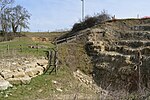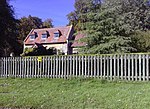Thornborough Bridge

Thornborough Bridge is located on the original Bletchley and Buckingham road, now bypassed by a modern bridge in 1974 for the A421. The bridge is accessible to walkers from an adjacent lay-by. The bridge straddles the parish boundaries of Thornborough and Buckingham (the parish boundary follows the line of Padbury Brook or The Twins, a tributary of the River Great Ouse), and dates from the end of the 14th century and is the only surviving mediaeval bridge in Buckinghamshire. The parish division is marked by a boundary stone in the middle of the bridge.The stone bridge is around 30 m (98 ft) long and 4 m (13 ft) wide, and spans the river by six low arches, with three refuges formed within the parapet on the south side. The bridge is Grade I listed by English Heritage.
Excerpt from the Wikipedia article Thornborough Bridge (License: CC BY-SA 3.0, Authors, Images).Thornborough Bridge
A421,
Geographical coordinates (GPS) Address Nearby Places Show on map
Geographical coordinates (GPS)
| Latitude | Longitude |
|---|---|
| N 51.99248 ° | E -0.93935 ° |
Address
A421
MK18 7DX
England, United Kingdom
Open on Google Maps










